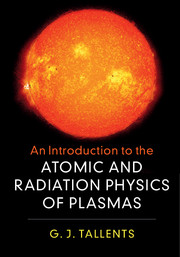Book contents
- Frontmatter
- Contents
- Preface
- 1 Plasma and Atomic Physics
- 2 The Propagation of Light
- 3 Scattering
- 4 Radiation Emission in Plasmas
- 5 Radiation Emission Involving Free Electrons
- 6 Opacity
- 7 Discrete Bound Quantum States: Hydrogen and Hydrogen-Like Ions
- 8 Discrete Bound States: Many-Electron Atoms and Ions
- 9 Discrete Bound States: Molecules
- 10 Radiative Transitions between Discrete Quantum States
- 11 Collisions
- 12 Collisional-Radiative Models
- 13 High-Density Plasmas
- Appendix Vectors, Maxwell's Equations, the Harmonic Oscillator and a Sum Rule
- References
- Index
1 - Plasma and Atomic Physics
Published online by Cambridge University Press: 21 February 2018
- Frontmatter
- Contents
- Preface
- 1 Plasma and Atomic Physics
- 2 The Propagation of Light
- 3 Scattering
- 4 Radiation Emission in Plasmas
- 5 Radiation Emission Involving Free Electrons
- 6 Opacity
- 7 Discrete Bound Quantum States: Hydrogen and Hydrogen-Like Ions
- 8 Discrete Bound States: Many-Electron Atoms and Ions
- 9 Discrete Bound States: Molecules
- 10 Radiative Transitions between Discrete Quantum States
- 11 Collisions
- 12 Collisional-Radiative Models
- 13 High-Density Plasmas
- Appendix Vectors, Maxwell's Equations, the Harmonic Oscillator and a Sum Rule
- References
- Index
Summary
A plasma is created by adding energy to a gas so that electrons are removed from atoms, producing free electrons and ions. Electric and magnetic fields interact strongly with the charged electrons and ions in plasmas (unlike solids, liquids and gases) and, consequently, plasmas behave differently to imposed electric and magnetic fields and modify electromagnetic waves in different ways to solids, liquids and gases. The different behaviour of plasmas has caused them to be regarded as a fourth fundamental state of matter in addition to solids, liquids and gases.
More than 99% of the observable universe is plasma. For example, the Sun is a plasma and has mass comprising 99.85% of the solar system, so the fraction of plasma in the solar system is slightly higher once interplanetary plasma is included. Present understanding of the universe has been enabled by the detection of electromagnetic radiation emitted by or passing through plasma material. To understand the universe, we need to understand plasmas, and, in particular, we need to understand the processes of light emission and propagation in plasmas.
Plasmas have many realised and potential applications. The fusion of isotopes of hydrogen in plasmas confined using magnetic fields or confined by inertia before a dense plasma can expand should provide a new source of energy production to replace the burning of fossil fuels, though the exact physics and many technical issues are not yet resolved [35]. The fuel for a fusion reactor (the deuterium isotope of hydrogen) is abundant in seawater (at concentration 33mg/litre). Large-scale experiments are under way to make fusion reactors because of the enormous potential impact of the development of a fusion power plant [79, 67].
Plasmas are used in many technological applications, including semiconductor etching and thin-film coating [15]. Plasma is created during the welding of solid material and is under study for biological and medical applications such as bacterial sterilisation. The emission of light from plasmas has many applications, ranging from fluorescent tubes to the use of extreme ultra-violet light emitted from laser plasmas for the lithography of semiconductors [105]. Many different lasers utilising plasmas have been developed, including argon ion lasers and an extensive array of plasma lasers designed to operate at short wavelengths [108, 91], with the record for saturated lasing achieved at wavelength 5.9 nm [125, 100].
Information
- Type
- Chapter
- Information
- Publisher: Cambridge University PressPrint publication year: 2018
